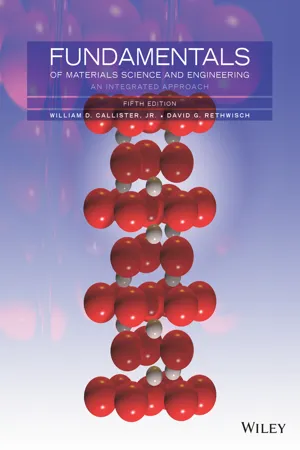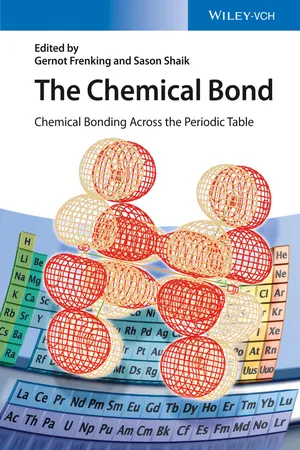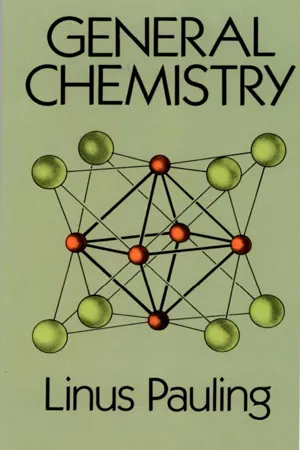Chemistry
Metallic Bonding
Metallic bonding is a type of chemical bonding that occurs in metals. It is characterized by the delocalization of electrons within a metal crystal lattice, leading to the formation of a "sea of electrons" that are free to move throughout the structure. This results in metals being good conductors of electricity and heat, as well as having high melting and boiling points.
Written by Perlego with AI-assistance
Related key terms
Related key terms
1 of 4
Related key terms
1 of 3
8 Key excerpts on "Metallic Bonding"
- Arshad Ahmed, John Sturges(Authors)
- 2014(Publication Date)
- Routledge(Publisher)
Figure 2.5 .The cations are all positively charged, and they will be subject to forces of attraction and also to forces of repulsion (their positive charges will form part of the repulsive force). The atoms will take up constant spacings from each other, and the distance apart will be the distance at which the attractive and repulsive forces are exactly equal. As we shall see, it is these forces that give the metal its elastic properties.Figure 2.4 Schematic representation of covalent bonding(After Smallman & Bishop, 1995)Figure 2.5 Schematic representation of Metallic Bonding(After Ashby & Jones, 1980)The ‘sea’ of electrons, coupled with the regular electrical periodicity, is what gives metals their excellent electrical conductivity properties. Finally, because all the atoms are lined up in a regular array, they are ideally positioned for the easy and rapid transmission of heat energy. So their crystalline structure confers on metals their excellent thermal conductivity properties as well.2.3.5 van der Waals and hydrogen bonding
Whenever atoms are in close proximity to each other, they will attract each other by weak electrostatic forces. These forces are seen even between chemically inert atoms like the inert gases. They are called van der Waals forces and they are much weaker than ionic or covalent forces. They are very short-range forces, and they exist between all atoms and molecules, regardless of whatever other forces may be involved. These forces are caused by the fact that, even though the average electrical field of a neutral, spherical atom is zero, its instantaneous field is not zero. This is due to the fact that the electrons within the atom will move and cause the field to fluctuate. If the electrons in one atom move and leave the positively charged nucleus somewhat exposed to the electrons in a second atom, the atoms are able to correlate their electronic movements so that they are attracted to each other, and so form a weak van der Waals bond.- eBook - ePub
Understanding Basic Chemistry
The Learner's Approach
- Kim Seng Chan, Jeanne Tan(Authors)
- 2014(Publication Date)
- WSPC(Publisher)
to gain electrons across the period!In a nutshell, remember:•Elements across a period experience increasing ease to gain electrons BUT decreasing ease to lose electrons.•Elements down a group experience decreasing ease to gain electrons BUT increasing ease to lose electrons.3.1 Metallic BondingChemical bonds are electrostatic forces of attraction (positive charge attracting negative charge) that bind particles together to form matter. When different types of particles interact electrostatically, different types of chemical bonds are formed. There are four different types of conventional chemical bonds, namely, metallic, ionic, covalent, and intermolecular forces.Within a metal, atoms partially lose their loosely bound valence electrons. These electrons are mobile and delocalized, not belonging to any one single atom and yet not completely lost from the lattice.A metal can thus be viewed as a rigid lattice of positive ions surrounded by a sea of delocalized electrons. What holds the lattice together is the strong Metallic Bonding — the electrostatic attraction between the positive ions and the delocalized valence electrons.Metallic bonds are strong and non-directional. Therefore, when a force is applied across a piece of metal, the metal atoms can slide over one another without breaking of the metallic bonds. This accounts for the malleability (can be deformed into different shapes) and ductility (can be drawn into wires) of metals.Since Metallic Bonding is the result of the interaction between the delocalized electrons and the positive ions, the strength of a metallic bond depends on:•The number - eBook - ePub
Fundamentals of Materials Science and Engineering
An Integrated Approach
- William D. Callister, Jr., David G. Rethwisch(Authors)
- 2018(Publication Date)
- Wiley(Publisher)
The structure of graphite is shown in Figure 3.18. Figure 2.18 The formation of a hexagon by the bonding of six sp 2 triangles to one another. Metallic Bonding Metallic Bonding Metallic Bonding, the final primary bonding type, is found in metals and their alloys. A relatively simple model has been proposed that very nearly approximates the bonding scheme. With this model, these valence electrons are not bound to any particular atom in the solid and are more or less free to drift throughout the entire metal. They may be thought of as belonging to the metal as a whole, or forming a “sea of electrons” or an “electron cloud.” The remaining nonvalence electrons and atomic nuclei form what are called ion cores, which possess a net positive charge equal in magnitude to the total valence electron charge per atom. Figure 2.19 illustrates Metallic Bonding. The free electrons shield the positively charged ion cores from the mutually repulsive electrostatic forces that they would otherwise exert upon one another; consequently, the metallic bond is nondirectional in character. In addition, these free electrons act as a “glue” to hold the ion cores together. Bonding energies and melting temperatures for several metals are listed in Table 2.3. Bonding may be weak or strong; energies range from 62 kJ / mol for mercury to 850 kJ / mol for tungsten. Their respective melting temperatures are − 39 ° C and 3414 ° C (− 39 ° F and 6177 ° F). Figure 2.19 Schematic illustration of Metallic Bonding. Metallic Bonding is found in the periodic table for Group IA and IIA elements and, in fact, for all elemental metals. Metals are good conductors of both electricity and heat as a consequence of their free electrons (see Sections 12.5, 12.6, and 17.4). Furthermore, in Section 8.5, we note that at room temperature, most metals and their alloys fail in a ductile manner—that is, fracture occurs after the materials have experienced significant degrees of permanent deformation - eBook - ePub
Solid State Chemistry
An Introduction
- Elaine A. Moore, Lesley E. Smart(Authors)
- 2020(Publication Date)
- CRC Press(Publisher)
4 Solids Bonding and Electronic Properties Neil Allan 4.1 Introduction In Chapter 1, we introduced you to the physical structure of solids—the arrangement of their atoms and ions in space. We now turn to describe bonding in solids—their electronic structure. Some solids consist of molecules bound together by very weak forces. We shall not be concerned with these because their properties are essentially those of the individual molecules. In the final section we shall be concerned with ‘purely ionic’ solids bound by electrostatic forces between ions, as discussed in Chapter 1. The solids considered here are those in which all the atoms can be regarded as bound together. We shall be looking at basic theories of bonding in these solids and how they account for the very different electrical conductivities of different groups of solids—metals, insulators, and semiconductors. In particular we explain Metallic Bonding, a type of bonding not found in small molecules and clusters, and the high conductivities of metals. We shall cover a theory based on the free-electron model, a view of a solid as an array of ions held together by a ‘sea’ of electrons; and another theory based on molecular orbital theory, a crystal viewed as a giant molecule. Some of the most important solids are semiconductors. Many solid-state devices—transistors, photocells, light-emitting diodes (LEDs), solid-state lasers, and solar cells—are based on semiconductors. We introduce examples of some devices and explain how the properties of semiconductors make them suitable for these applications - eBook - ePub
The Chemical Bond
Chemical Bonding Across the Periodic Table
- Gernot Frenking, Sason Shaik(Authors)
- 2014(Publication Date)
- Wiley-VCH(Publisher)
Among the different possible classifications of solids, it is quite usual to distinguish them according to the main cohesive forces keeping the atoms or molecules together. The four types of solids described in the introductory chapters of any solid state chemistry textbook are ionic, molecular, covalent, and metallic solids [1–3]. Molecular solids are composed from individual atoms or molecules that retain their individuality and are kept together by weak van der Waals forces, in the case of nonpolar constituents, or more directional electrostatic forces such as dipole–dipole interactions or hydrogen bonding, for more polar constituents. In ionic solids, the electrostatic interactions are assumed to provide the leading cohesive force. Of course, a purely ionic bond does not occur; between any pair of bonded species some degree of electron sharing, that is, covalence, occurs. However, when the electronegativity difference between constituents is considerable, an ionic model leads to useful organizing structural principles such as the Goldschmidt and Pauling rules [4]. When the electronegativity differences decrease, covalent bonding takes the lead. In contrast, in the case of ionic bonding, a satisfactory approach to covalent bonding needs the use of a quantum mechanical treatment. Valence bond and molecular orbital (or its solid state counterpart crystal orbital) approaches have been used to develop our understanding of covalent bonding in solids. Although both approaches can be made equivalent at the limit, and the use of one or the other is often a question of preference, the second has been more popular probably because of its simplicity and easiness to correlate the structural and electronic details even for quite complex structures. The bonding in covalent solids and molecules is governed by the same rules. In particular, a localized description in terms of electron pairs either as chemical bonds and/or lone pairs is conceptually possible although a more delocalized description may be more informative. Finally, when such a localized description is no more possible and the electrons are delocalized among many atoms, we deal with Metallic Bonding. In contrast to the common belief, this situation is not peculiar of solids; bonding in some discrete transition-metal clusters or electron-deficient molecules has exactly the same origin. In metallic solids, the electrons are delocalized throughout the whole solid and require the delocalized quantum mechanical description of band theory.Benzene, NaCl, diamond, and sodium are archetypal examples of molecular, ionic, covalent, and metallic solids. However, these are almost ideal solids. For most of the interesting solids, overlapping of several types of bonding is the rule. In such a simple solid as graphite, bonding has covalent, metallic, and van der Waals components; TiO presents both metallic and covalent bonding features; (TMTSF)2 PF6 (where TMTSF stands for bis-tetramethyl-tetraselenafulvalene), the first molecular conductor that could be made superconducting under pressure, combines the four types of bonding forces in a same crystal structure. Although such a classification is clearly not quite functional for the majority of compounds, it certainly draws attention to some very general aspects of bonding, which can be useful as a starting point to understand chemical bonding in solids.From a practical viewpoint, the different bonding forces acting in a solid are all taken care of in contemporary computational approaches based on the density functional theory (DFT) or Hartree–Fock (HF) schemes [5], although the first is by far the more popular in the solid-state community. Band theory (based on the notion of crystal orbitals, the solid state counterpart of molecular orbitals) provides the more straightforward construction to analyze the bonding and properties of periodic solids. In the same way that molecular orbitals are delocalized through the entire molecule, the crystal orbitals are delocalized through the solid. Thus, the band theory may be less well suited for the study of properties such as magnetism based on the behavior of localized electrons. Modern implementations of DFT have provided nevertheless a really impressive list of successful applications to solids of very different nature so that DFT has become the method of choice for studies of the electronic structure of most solids. - eBook - ePub
- Linus Pauling(Author)
- 2014(Publication Date)
- Dover Publications(Publisher)
17
The Nature of Metals and Alloys
About eighty of the more than one hundred elementary substances are metals. A metal may be defined as a substance that has large conductivity of electricity and of heat, has a characteristic luster, called metallic luster, and can be hammered into sheets (is malleable) and drawn into wire (is ductile); in addition, the electric conductivity increases with decrease in temperature.*17-1. The Metallic Elements
The metallic elements may be taken to include lithium and beryllium in the first short period of the periodic table, sodium, magnesium, and aluminum in the second short period, the thirteen elements from potassium to gallium in the first long period, the fourteen from rubidium to tin in the second long period, the twenty-nine from cesium to bismuth in the first very long period (including the fourteen rare-earth metals), as well as the eighteen from francium to khurchatovium.The metals themselves and their alloys are of great usefulness to man, because of the properties characteristic of metals. Our modern civilization is based upon iron and steel, and valuable alloy steels are made that involve the incorporation with iron of vanadium, chromium, manganese, cobalt, nickel, molybdenum, tungsten, and other metals. The importance of these alloys is due primarily to their hardness and strength. These properties are a consequence of the presence in the metals of very strong bonds between the atoms. For this reason it is of especial interest to us to understand the nature of the forces that hold the metal atoms together in metals and alloys.17-2. The Structure of Metals
In a nonmetal or metalloid the number of atoms that each atom has as its nearest neighbors is determined by its covalence. For example, the iodine atom, which is univalent, has only one other iodine atom close to it in a crystal of iodine: the crystal, like liquid iodine and iodine vapor, is composed of diatomic molecules. In a crystal of sulfur there are S8 molecules, in which each sulfur atom has two nearest neighbors, to each of which it is attached by one of its two covalent bonds. In diamond the quadrivalent carbon atom has four nearest neighbors. On the other hand, the potassium atom in potassium metal, the calcium atom in calcium metal, and the titanium atom in titanium metal, which have one, two, and four outer electrons, respectively, do not have only one, two, and four nearest neighbors, but have, instead, eight or twelve nearest neighbors. We may state that one of the characteristic features of a metal is that each atom has a large number of neighbors; the number of small interatomic distances is greater than the number of valence electrons. - eBook - ePub
- Sir Alan Cottrell(Author)
- 2019(Publication Date)
- CRC Press(Publisher)
It is thus possible to make alloys over wide ranges of composition by randomly replacing atoms of one metal by those of another, so forming substitutional solutions. The insensitivity of the metallic bond to the particular metal atoms involved is also responsible for the ability of metals to be joined by welding and soldering. In principle, it is sufficient merely to bring clean metal surfaces into contact for them to bond. The undirected nature of the metallic bond also influences the surface and mechanical properties of metals. If a metal is cut into two pieces along some surface, the bonds which previously crossed that surface transfer themselves to atoms within each of the new surfaces so created. The surface energy of a metal is thus rather smaller than might be expected purely from the number of bonds intersected by the cut. As regards mechanical properties, it is easier in metals than most other substances for atoms to slide over one another without breaking bonds. Ultimately, the ductility and toughness of metals are due to this property, although their explanation requires a detailed analysis of the way the atoms move (cf. Chapter 21). The immunity of metals to radiation damage by ionization is also a consequence of the free electron structure. Fast charged particles and ionizing rays can strip electrons off the atoms they pass through on their journey. In metals this matters little because the positive holes so formed can immediately fill up again from the free electron sea, leaving no trace of the damage apart from a little heat. In non-metals, by contrast, where the electrons are localized in bonds, electronic excitation and ionization by radiation can have drastic effects. In ionic solids and glasses the electrons may become trapped at atomic irregularities in the structure and there produce ‘colour centres’, so that the material becomes coloured and eventually black - eBook - ePub
- Michel Barsoum(Author)
- 2019(Publication Date)
- CRC Press(Publisher)
2Bonding in Ceramics
All things are Atoms: Earth and Water, Air And Fire, all,Democritus foretold. Swiss Paracelsus, in’s alchemic lair,Saw Sulfur, Salt, and Mercury unfold Amid Millennial hopes of faking Gold. Lavoisier dethroned Phlogiston; then Molecular Analysis made bold Forays into the gases: Hydrogen Stood naked in the dazzled sight of Learned Men.John Updike; The Dance of the Solids* *2.1 Introduction
The properties of a solid and the way its atoms are arranged in 3D are determined primarily by the nature and directionality of the bonds holding the atoms together. Consequently, to understand variations in properties, it is imperative to appreciate how and why a solid is “glued” together.This glue can be strong, which gives rise to primary bonds , which can be ionic, covalent or metallic. Usually van der Waals and hydrogen bonds are referred to as secondary bonds and are weaker.In all cases, however, it is the attractive electrostatic interaction between the positive charges of the nuclei and the negative charges of the electrons that is responsible for the cohesion of solids.Very broadly speaking, ceramics can be classified as being either ionically or covalently bonded and, for the sake of simplicity, this notion is maintained throughout this chapter. However, that this simple view needs some modification will become apparent in Chap. 4; bonding in ceramics is neither purely covalent nor purely ionic, but a mixture of both. Interestingly, in some ceramics, such as the MAX phases and transition metal carbides and nitrides, the bonding is a combination of metallic and covalent.Before the intricacies of bonding are described, a brief review of the shape of atomic orbitals is presented in Sec. 2.2. The concept of electronegativity and how it determines the nature of bonding in a ceramic is introduced in Sec. 2.3. In Secs. 2.4 and 2.5, respectively, the ionic bond is treated by a simple electrostatic model, and how such bonds lead to the formation of ionic solids is discussed.
Index pages curate the most relevant extracts from our library of academic textbooks. They’ve been created using an in-house natural language model (NLM), each adding context and meaning to key research topics.
Explore more topic indexes
Explore more topic indexes
1 of 6
Explore more topic indexes
1 of 4







